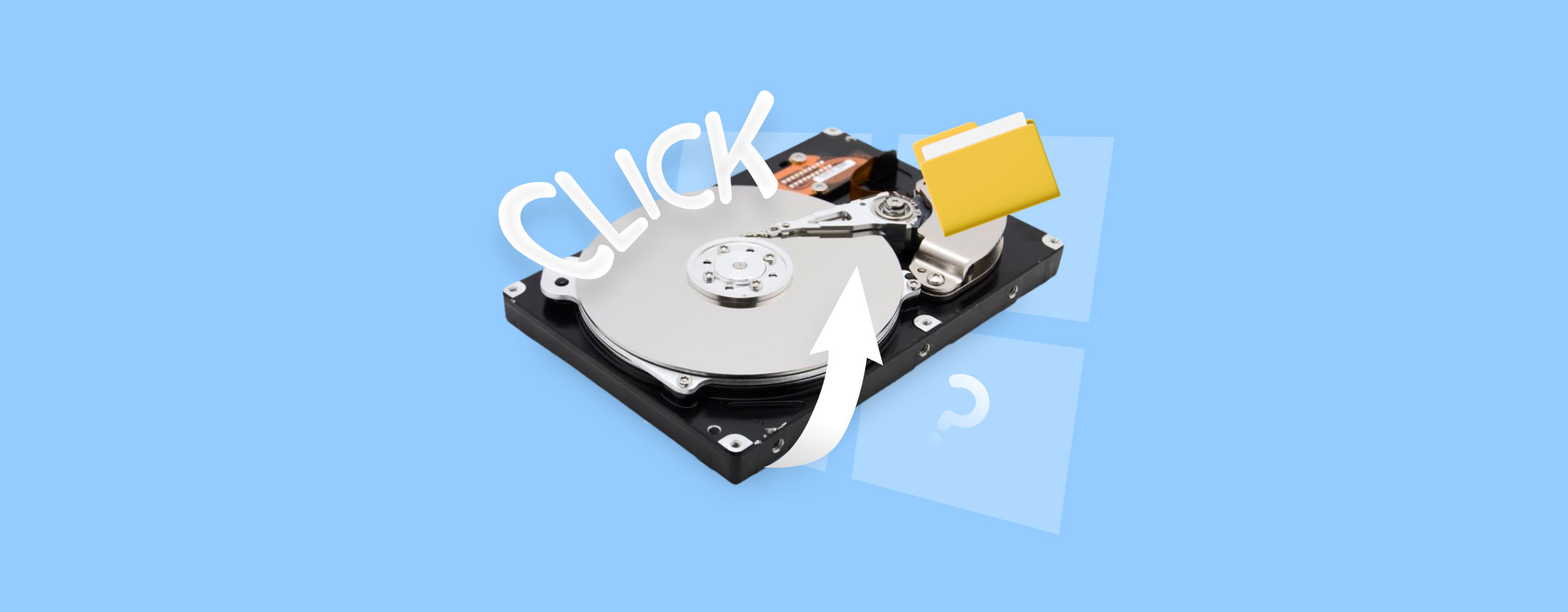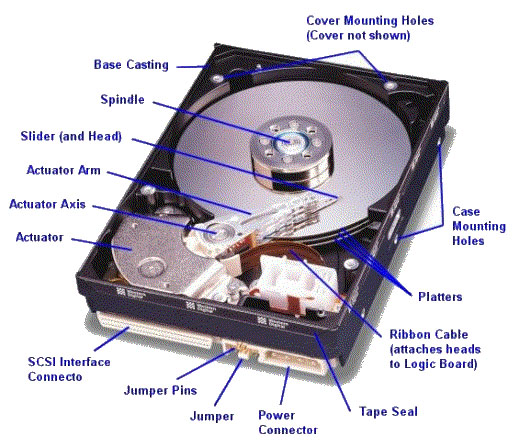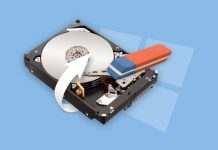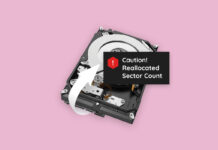 Hear an odd, consistent clicking sound from your hard drive, instead of the usual comforting hum? There’s no sugarcoating it—this usually occurs on hard drives on the verge of failure, and is appropriately called the “hard drive click of death”. However, we’ve dealt with several similar scenarios. What we’ve learnt is that you can recover data from a clicking hard drive and preserve any existing files. It’s also easier than you think. But, time is of the essence here—attempt the expert-approved methods in the sections below as soon as you can.
Hear an odd, consistent clicking sound from your hard drive, instead of the usual comforting hum? There’s no sugarcoating it—this usually occurs on hard drives on the verge of failure, and is appropriately called the “hard drive click of death”. However, we’ve dealt with several similar scenarios. What we’ve learnt is that you can recover data from a clicking hard drive and preserve any existing files. It’s also easier than you think. But, time is of the essence here—attempt the expert-approved methods in the sections below as soon as you can.
Why Is My External Hard Drive Clicking
If your external hard drive is clicking, it’s mainly because of a mechanical issue–typically with the read/write head, and the head actuator of your drive. The clicking is constant and loud. Due to their use case, and frequent transportation, external hard drives are more likely to experience mechanical problems. External HDDs are also more likely to experience detection issues.
It’s worth mentioning that some hard drives have a clicking sound by design. Ironically, you’ll hear this sound when the hard drive’s Preventative Wear Leveling (PWL) feature comes into play—it moves the read/write heads periodically to distribute the lubricant evenly across the platter, which in turn extends the drive’s lifespan. It’s best to double-check if the sound is normal for your drive by Googling the exact model number and checking for related forum, or Reddit threads by other users.
Internal HDDs usually develop the clicking issue because of age, and regular wear and tear. Mainly because they’re less likely to be dropped or suffer other forms of physical shock.

Some common reasons for clicking noises on your hard drive are listed in the table below:
|
Reason |
Description |
| ✍️ Read/Write Head Issue | The Read/Write head on your HDD reads and writes data to the HDD platter. There’s a minuscule gap (about 5nm) between the actual head and the platter. Physical shock, as well as debris, can cause the read/write head to become misaligned or crash, i.e., drag across the platter, resulting in clicking noises. |
| ⚠️ Problems With The Head Actuator | The head actuator is responsible for moving the read/write head to the appropriate location and facilitating it to read/write data to your drive. Clicking sounds can be an indicator of a failed head actuator. |
| 🚨 Physical Damage | Exposure to harsh magnetic fields, high temperatures, blunt force trauma, and water can damage the numerous components that are crucial to the functioning of the HDD. |
| 💽 Damaged Disk Platter | Any damage to the disk platter will result in the actuator arm swinging back and forth as it attempts to detect the platter. Consequently, you’ll hear a clicking sound. |
| 🔌 Electrical Faults | Inadequate power and power surges can both result in the HDD not functioning properly, leading to clicking noises. Your PC may have a faulty power supply or power cables. Additionally, damage to the Printed Circuit Board (PCB) of the hard drive can cause clicking noises. |
| 🦾 Service Area Failure | An HDD’s service area is where manufacturer data is stored. Any damage to it, and the actuator arm will swing back and forth in an attempt to read it. |
| ⌛ Wear and Tear | Over a period of time, your HDD will go through wear and tear. The head actuators, read/write heads, and the head arm are the first components to fail, causing clicking noises. If a new hard drive is clicking, it’s because of a manufacturing defect, and you should get it replaced. |
How to Recover Data from a Clicking Hard Drive
In most cases, a clicking hard drive will not be detected by your PC, and the only way to get back your data is to use a professional data recovery service. However, if your drive is detected by your PC, you can use third-party data recovery tools to salvage your data.
Note: To confirm that your drive is detected by your computer (even if Windows Explorer doesn’t display it), look for it in Disk Management. Right-click the Start button, click on Disk Management, and look for the clicking hard drive in the drive list in the bottom half. If it’s listed with its correct storage capacity, DIY data recovery can be attempted.
Don’t worry if the drive shows up as RAW, or with unallocated space in Disk Management because the data recovery app we’ll use can detect and recover data from your hard drive regardless of its file system.
If the clicking hard drive is visible in Windows Explorer and you can still access your files, try copying them to another location as soon as possible. But, you’re likely here because that’s not the case, and you need to recover deleted data, and inaccessible existing files.
The sections below will take a look at two methods of clicking hard drive data recovery.
Method 1: Data Recovery Software
While data recovery software can be used to perform data recovery from a clicking hard drive, I still suggest contacting a professional data recovery service. Simply because the chances of additional damage increase as you use an already damaged hard drive.
However, these services do cost a pretty penny, and if that’s not an option, the next safest way for clicking hard disk recovery is data recovery software.
For this tutorial, I opted to use Disk Drill. Why? Because it lets you create a byte-level disk image of your drive and then scan it for data. It supports both external and internal hard drives, so you don’t need to worry about compatibility.
Directly scanning a clicking hard drive stresses it out and exponentially increases the damage. Using Disk Drill’s Byte-to-byte backup feature in conjunction with its advanced data recovery algorithm, you’ll be able to get back your data without damaging the drive any further.
Additionally, the backup feature skips data blocks it can’t read, and scans them later in small clusters once the remaining blocks are backed up. This ensures that most of your data is backed up, and the process isn’t stuck in one place.
Note: If you’re attempting clicking hard drive from an internal HDD, you’ll need a hard drive enclosure to connect it to another PC to perform data recovery.
Step 1: Create a Byte-to-byte Backup of the Clicking Hard Disk Drive
- Download Disk Drill and install it. Do this on a separate drive, not the one that’s clicking.
- Open Disk Drill, and click on Byte-to-byte Backup, under Extra tools.
- Select the clicking hard drive, and click on Create backup.

- Pick where you wish to store the disk image by clicking the three dots (…) next to Path. Make sure the destination has enough free space—equal to, or more than the clicking hard drive’s total storage capacity—to store the disk image. If needed you can modify other parameters like the disk image type, format, name, and more. Once you’re done, click OK.

- Disk Drill will begin creating the disk image. Keep a watch on the area below Disk surface map as any bad blocks will appear in red—it’s a good way to assess how damaged the drive is. The entire backup process may take a while, depending on your clicking hard drive’s storage capacity and your PC’s specs.

For all you advanced users out there, Disk Drill lets you fine tune the backup process using Windows’ Registry Editor, or macOS’ Terminal. These are some parameters you can modify:
- backupSkipBlocks (0 to 128): The number of blocks to automatically skip after encountering a bad block.
- backupRetryCount (0 to 10): The number of additional attempts to read a bad block when Disk Drill encounters one.
- backupBlockSize (131072–2097152):This lets you modify the backup block size (value in bytes) manually. The value must align with your drive’s sector size.
Step 2: Scan the Disk Image Using Disk Drill
- Open Disk Drill, and ensure you’re on the Storage Devices tab, under Data Recovery.
- Click on Attach disk image, browse for the disk image you’d created in the previous section, and double-click on it. It’ll be added to the list of storage drives in Disk Drill.

- Select the disk image of the clicking hard drive, and click on Search for lost data to begin the data recovery scan. You can pause or resume the scan at any time.

- If you see a prompt asking you to choose between a Universal Scan or Advanced Camera Recovery, pick Universal Scan.

- Click on Review found items to view all the files Disk Drill has discovered. Want to filter the results? Click on the relevant file type tiles instead—Pictures, Videos, Audio, Documents, Archives, and Other.

- Expand the Existing, Deleted or lost, and Reconstructed sections to view currently stored files, recoverable deleted files, and recoverable files whose filenames and folder tree couldn’t be recovered, respectively.

- Select the files you wish to recover. Disk Drill displays a preview of the currently selected file, but you can manually preview any file by clicking the eye icon next to its filename. Files that can be previewed have exponentially higher chances of recover than ones that cannot. Additionally, Disk Drill also lists the recovery chances of each file next to it. Click on Recover once you’re done selecting the files.

- Choose a recover destination for the files, and click Next. Don’t attempt recovering the files to the problematic disk itself, choose another drive.

- Disk Drill will recover the files.

Method 2: Professional Data Recovery Service
If your data is critical, and you’re willing to spend a substantial amount of money, a professional data recovery service will be able to repair a clicking hard drive, or at least get your data from it in 90% of cases.
Always do your research before choosing a data recovery service because you’re trusting them with your private data, and they’re exponentially more expensive than any other data recovery method. A service we constantly recommend to users is CleverFiles Data Recovery Center, thanks to their high success rate across the board (inlcuding clicking HDD recovery), free evaluation, focus on user privacy, and clear instructions.
Here’s an overview of what to expect when using a professional data recovery service:
- 📞 Contact the data recovery service or submit a recovery request using the company’s website. Provide the relevant details, such as when the clicking issue occurred and whether you dropped the hard drive, exposed it to heat, water, magnetic fields, etc.
- 🚚 You’ll have to ship the clicking hard drive to the company or drop it off at a drop-off location.
- 🔧 The data recovery service will evaluate the drive to determine the possibility and extent of data recovery. A reputable data recovery service will not charge you up to this point.
- 💵 After the evaluation is over, the data recovery service will provide you with a quote, and you can choose whether to proceed with data recovery or not.
- ✅ If you proceed, the company will recover your data, transfer it to a brand-new drive, and ship it back to you.
How to Fix a Clicking Hard Drive
Since power issues can result in a clicking hard drive, it’s a good idea to connect the drive to another PC and see if the problem persists. Additionally, try using different cables and power connectors. A malfunctioning power supply unit (PSU) can also cause issues on your HDD. This is easy to determine, since a damaged PSU will affect the functioning of other components of your PC as well.
Besides power issues, and physical damage, excessive file fragmentation can result in a clicking hard drive. Windows doesn’t store data in contiguous data blocks—the data that makes up a file is fragmented, and then put together when you access it. In case of fragmentation, the clicking will be most noticeable when you’re copying large amounts of data to your drive.
Running Windows Disk Defragmentation can be an effective hard drive clicking fix. However, only do this if you’re sure that file fragmentation is what’s causing the clicking sound, and your drive isn’t damaged. If it is damaged, defragmentation will deteriorate the drive’s condition further.
Here’s how to defragment and repair a clicking hard drive on Windows:
- Type “defrag” in Windows Search (Windows Key + S). Click on Defragment and Optimize Drives.

- Select the clicking hard drive from the drive list, and click on Optimize.

- Windows will begin the defragmentation process. It may take a while depending on the hard drive’s total storage capacity.
Closing Thoughts
Not to be a buzzkill, but “saving” a clicking hard drive is usually impossible. What you can do, is perform clicking hard drive data recovery. If the drive’s visible in Disk Management with its correct storage capacity, go the DIY router and recover your files using a data recovery program. Else, contact a professional data recovery service—be warned, these can be expensive.
In some cases, excessive data fragmentation could be what’s causing the clicking sound on your hard drive. Here, the drive can be “fixed” by running Windows Defragmentation.
We hope this guide helped you with clicking hard disk recovery. If you’re still facing any issues, leave a comment below, and we’ll respond as soon as possible. Oh, and remember, the best method to recover data from a clicking hard drive is to create regular backups of important data.
FAQ
- The drive is not receiving enough power to fully spin and power up.
- The drive has failed or is about to fail.
- The drive’s data cable is damaged or faulty.




